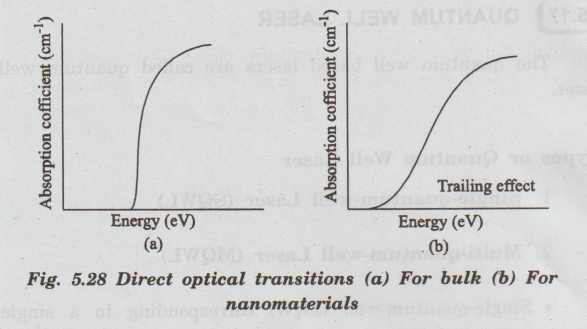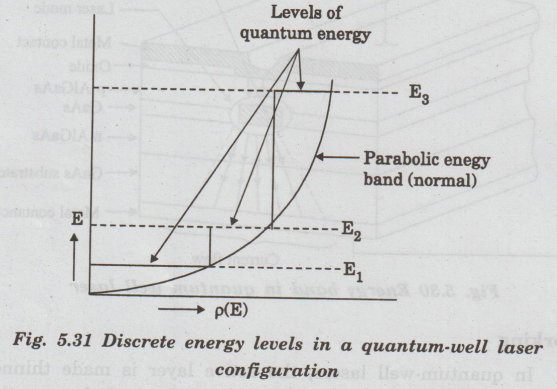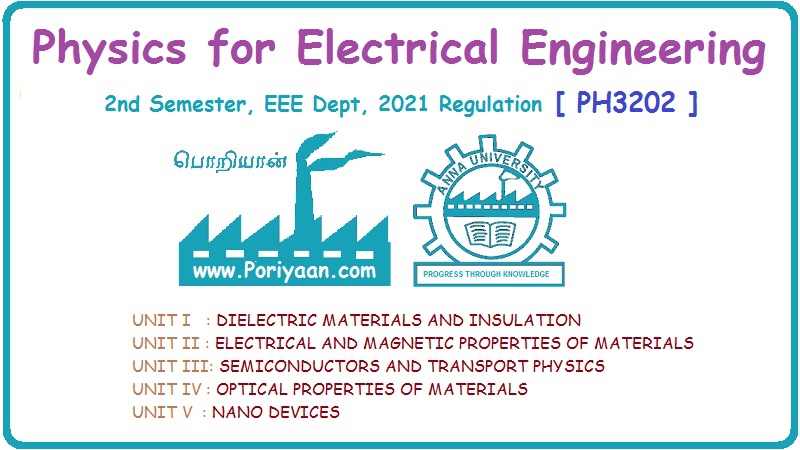Physics for Electrical Engineering: Unit V: Nano Devices
Quantum well laser
Types, Working Principle, Advantages, Disadvantages, Applications, Uses | Nano Devices
The quantum well based lasers are called quantum well laser.
QUANTUM WELL LASER
The
quantum well based lasers are called quantum well laser.
Types or Quantum Well Laser
1.
Single-quantum-well Laser (SQWL)
2.
Multi-quantum-well Laser (MQWL)
•
Single-quantum-well (SQW) corresponding to a single active region and
multi-quantum-well corresponding to multiple active regions. (MQW)
•
When the bandgap energy of the barrier layer differs from the cladding layer in
an MQW device, it is usually referred to as a modified multi-quantum-well laser
(MMQWL)
A
quantum well laser is shown in fig.5.29 The active laser (GaAs) is in between
p-type AlGaAs and n-type AlGaAs. The metal contacts are provided to bias the
QWL. The energy band diagram of QWL is shown in (b)
In
this laser the current is confined to narrow strip. It will limit the amount of
current flowing in the laser, and thus prevent thermal damage to the
semiconductor.
This,
also limit the laser gain region and in turn the dimension of the laser mode in
the lateral direction. So, when the current flows through the layers of the
semiconductor into the active region, it produces gain only in a narrow
Gaussian-shaped stripe. This is shown in fig. 5.30.

Working
In
quantum-well lasers, the active layer is made thinner than 10 nm. Therefore,
the electronic and the optical properties are drastically altered due to the
reduced dimensionality. Thus, the motion of the free electrons are confined in
one direction and free other two mutually perpericular directions.
The
electron confinement results in a quantisation in the permitted energy levels.
En
= h2 n2 / 8mL2
Here,
h is Planck's constant, m the effective mass of the electrons, n an integer and
L, the thickness of the quantum well. The valence band also can have discreate
energy levels.
The
variation of spacing of the band-gap in semiconductor materials can vary the
wavelength of laser emission.
It
can be made by using different bandgap semiconductor in active region.
The
discrete energy levels associated with quantum-well laser geometry is shown in
fig. 5.31.

For
quantum-wells, a graph of energy versus density of states does not follow the
parabola. Instead, it has a distribution that has steps as shown in fig.5.31.
At the level of threshold current, electrons occupy only the place above the
first level of energy i.e. E1.
When
transitions take place between the level it gives narrower wavelengths than for
the bulk material. This is because the graph of ρ (E) verses E is very narrow.
Here,
the electrons isolated over a much narrower range of energy than in normal
semiconductors.
This
results in higher gain at much lower threshold current. In quantum-well lasers
threshold current as low as 0.5 milliamp/cm have been achieved.
The
wavelength of the laser can be changed by:
(a)
Varying the thickness of the quantum-well.
(b)
Varying the composition of the quantum-well. This happens due to the change in
the energy band-gap.
Advantages of quantum well lasers
Quantum
well lasers have attracted a great deal of attention by their many advantages
such as
•
Low threshold current density.
•
excellent temperature feature
•
high modulation rate and
•
wavelength adjustability etc.
Disadvantages of quantum well lasers
A
disadvantage is that MQW lasers produce a broader linewidth than SQW ones the
most important characteristic of a semiconductor junction is the fact that the
crystalline structure of the material must be continuous across the junction.
Applications of Quantum well laser
Quantum-well
(QW) active semiconductor lasers enjoy widespread commercial use in
•
optoelectronic applications ranging from high-power noilar sources for medical
therapy
•
material processing
•
laser printing, and pumps for solid-state laser to lower output power
single-mode
•
Single-mode fasoll single-frequency for sources telecommunications.
Physics for Electrical Engineering: Unit V: Nano Devices : Tag: : Types, Working Principle, Advantages, Disadvantages, Applications, Uses | Nano Devices - Quantum well laser
Related Topics
Related Subjects
Physics for Electrical Engineering
PH3202 2nd Semester 2021 Regulation | 2nd Semester EEE Dept 2021 Regulation
